 CLOUD
CLOUD
 CLOUD
CLOUD
 CLOUD
CLOUD
Last week’s AWS re:Invent conference underscored the degree to which cloud computing generally and Amazon Web Services Inc. specifically have disrupted the technology landscape. From making infrastructure deployment simpler to accelerating the pace of innovation to the formation of the world’s most active and vibrant technology ecosystem, it’s clear that AWS has been the No. 1 force for industry change in the last decade.
Going forward, we see three high-level contributions from AWS that will drive the next 10 years of innovation: 1) the degree to which data will play a defining role in determining winners and losers; 2) the knowledge assimilation effect of AWS’ cultural processes such as two-pizza teams, customer obsession and working backwards; and 3) the rise of superclouds – that is, clouds built on top of hyperscale infrastructure that focus not only on information technology transformation, but on deeper business integration and digital transformation of entire industries.
In this Breaking Analysis, we’ll review some of the takeaways from the 10th annual AWS re:Invent conference and focus on how we see the rise of superclouds will have big impacts on the future of virtually all industries.
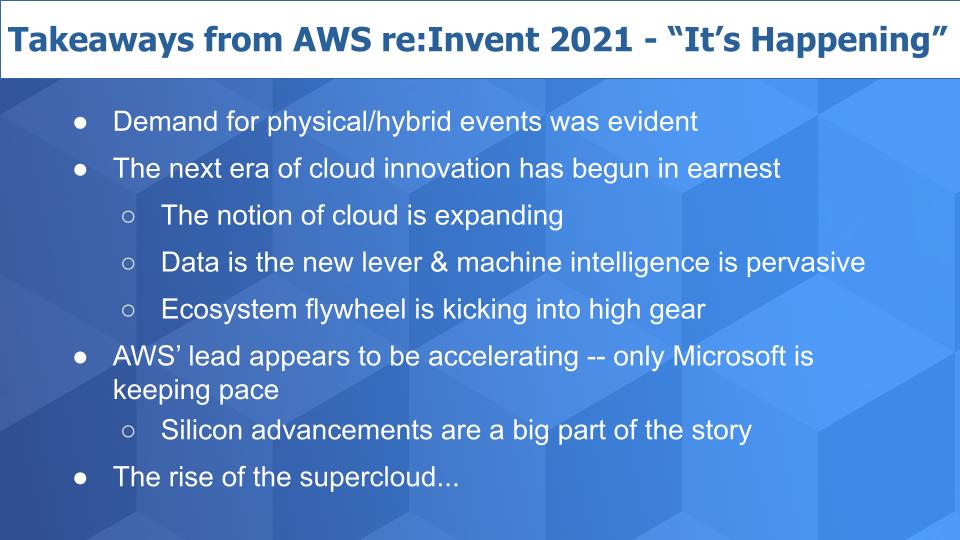
AWS re:Invent 2021 was the most important hybrid tech event of the year. No one really knew what the crowd would be like, but well over 20,000 people came to re:Invent, and probably an additional 5,000 to 10,000 folks came without badges to have meetings and do networking off the expo floor. So somewhere well north of 25,000 people physically attended the event, with 200,000-plus more online — huge for this year.
One of the most telling moments at re:Invent was a conversation with Steve Mullaney, chief executive of networking company Aviatrix Systems Inc. Just before we went on theCUBE, Nick Sturiale, managing partner at Ignition Partners, one of Aviatrix’ venture capital backers, looked at Steve and said: “It’s happening.”
What Sturiale meant by “It’s happening” is that the next era of cloud innovation is here and is beginning in earnest. The cloud is expanding out to the edge: AWS is bringing its operating model, application programming interfaces, primitives and services to more and more locations. Companies such as Aviatrix, and many others, are building capabilities on top of the cloud that don’t exist from the cloud providers today. And their strategy is to move fast in their respective domains to stay ahead and add value.
Yes, data and machine learning are critical – we talk about that all the time — but the ecosystem flywheel was so evident at this year’s re:Invent. Partners were charged up. There wasn’t nearly as much chatter about AWS competing with them. Rather, there was much more excitement around the value these partners are creating on top of AWS’ massive platform.
Despite aggressive marketing from competitive hyperscalers, other cloud providers and as-a-service on-premises and hybrid offerings, AWS’ lead appears to be accelerating. A notable example is AWS’ efforts around custom silicon. Far more companies, especially independent software vendors, are tapping into AWS’ silicon advancements.
We saw the announcement of Graviton3 and new chips for training and inference. As we’ve reported extensively, AWS is on a curve that will outpace Intel Corp.’s x86 chips in performance, price/performance, cost, power consumption and speed of innovation. And its Nitro platform is giving AWS and its partners the greatest degree of optionality in the industry – from central processing units, graphics processing units, Intel, Advanced Micro Devices Inc., Nvidia Corp. and, very importantly, Arm-based custom silicon springing from AWS’ acquisition of Annapurna Labs.
AWS started its custom silicon journey in 2008 and has invested massive resources into this effort. Other hyperscalers, which have the scale economics to justify such efforts, are just recently announcing initiatives in this regard. Others that don’t have the scale will be relying on third-party silicon providers– a perfectly reasonable strategy.
But because AWS has control of the entire software and hardware stack, we believe it has a strategic advantage in this respect. Silicon especially is a domain where – to quote Amazon.com Inc. CEO and former AWS CEO Andy Jassy – there is no compression algorithm for experience. Being on the curve matters. A lot.
Listen to AWS’ Dave Brown talk about the company’s custom silicon journey.
And the biggest trend in our view this past week was the clear emergence of superclouds.
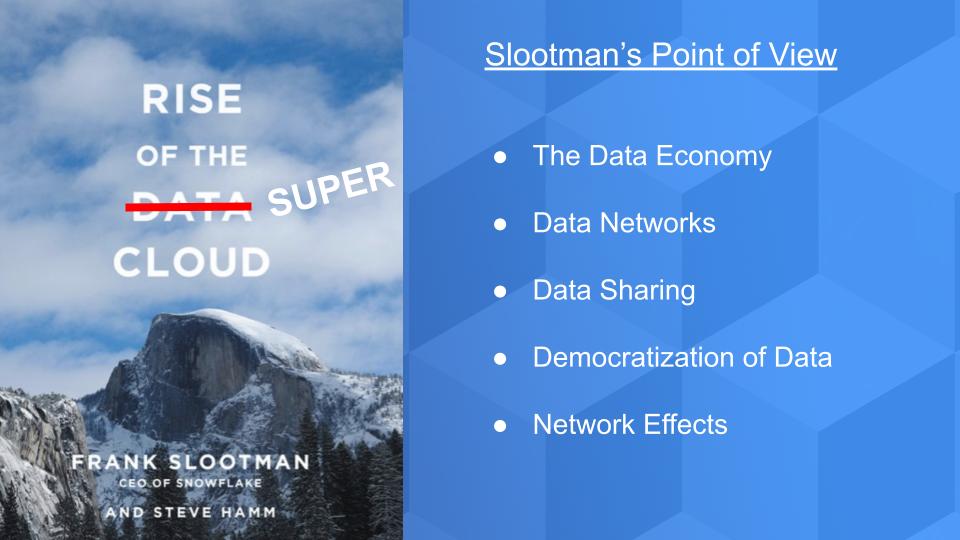
In his 2020 book “Rise of the Data Cloud,” written with Steve Hamm, Snowflake Inc. CEO Frank Slootman laid out the premise for the emergence of data cloud, a title that we’ve stolen in part for this Breaking Analysis — thank you, Frank Slootman. In his book, he made a case for companies to put data at the center of their organizations – rather than organizing just around people, for example.
The idea is to create data networks. Although people are of course critical, organizing around data and enabling people to access and share data will lead to the democratization of data and network effects will kick in – kicking off a renaissance in business productivity.
Essentially this is Metcalfe’s Law for data. Bob Metcalfe, the inventor of Ethernet, put forth the premise when we both worked for Pat McGovern at IDG. It states that the value of a network is proportional to the square of the number of its users on the network. Thought of another way, the first connection isn’t so valuable but the billionth is really valuable.
Slootman’s Law, if you will, says the more people that have access to the data (governed of course) and the more data connections that can be shared, the more value will be realized from that data. Exponential value, in fact.
Supercloud is a term we first referenced in the post led by John Furrier prior to re:Invent. Supercloud describes an architecture that taps the underlying services and primitives of hyperscale clouds to deliver additional value above and beyond what’s available from public cloud providers. A supercloud delivers capabilities through software, consumed as services, and can run on a single hyperscale cloud or span multiple clouds.
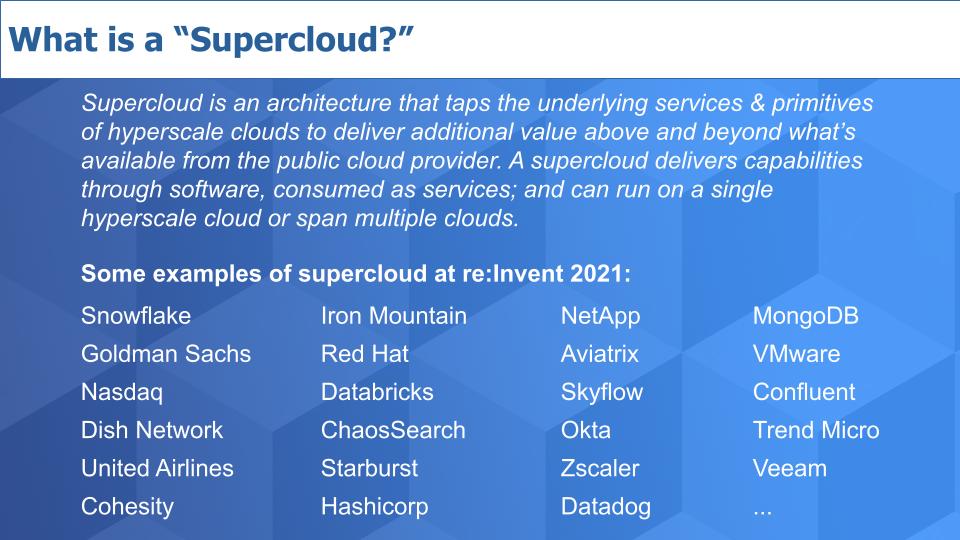
In fact, to the degree that a supercloud can span multiple clouds — and on-premises workloads — and hide the underlying complexity of the infrastructure supporting this work, the more adoption and value will be realized.
We’ve listed some examples above of what we consider to be superclouds in the making. Snowflake is one of our favorite to cite and we use it frequently. It’s building a data cloud that spans multiple clouds and supports distributed data, but governs that data centrally – somewhat consistent with the data mesh approach.
Listen to how Snowflake co-founder Benoit Dageville thinks about data mesh.
Goldman Sachs Group Inc. announced at re:Invent this year a new data management cloud — the “Goldman Sachs Financial Cloud for Data with AWS.” We’ll come back to that later in more detail, but it’s a prime example of an industry supercloud.
Nasdaq CEO Adena Friedman spoke at the day one keynote and talked about the supercloud it’s building. Dish Network Corp. is building a supercloud to power 5G wireless networks. United Airlines Inc. is, at this time, focused on porting applications to AWS as part of its digital transformation, but eventually we predict it will start building out a supercloud travel platform. What was most significant about the United effort is the best practices it’s borrowing from AWS, such as small teams and moving fast. AWS is teaching customers how to build a culture to support the buildout of superclouds.
But many others that we’ve listed above are on a supercloud journey. Just some of the folks we talked to at re:Invent that are building clouds on top of clouds are shown. Cohesity Inc. is building out a data management supercloud focused on data protection and governance. Hashicorp announced its IPO at a $13 billion valuation– building an IT automation supercloud. Databricks Inc., ChaosSearch Inc., Zscaler Inc., which is building a security supercloud, and many others that we spoke with at the event.
We want to take a moment to talk about “Castles in the Cloud.” It’s a premise put forth by Jerry Chen and the team at Greylock. It’s a really important piece of work that is building out a dataset and categorizing the various cloud services to understand better where the cloud giants are investing and where startups can participate, how companies can play in the castles built by the hyperscalers, how they can cross the moats that have been built and where the innovation opportunities exist.
Superclouds are strong examples of companies leveraging the castles and crossing the moats built by hyperscalers.
Frequently, we’re challenged about our statements that there are only four hyperscalers – AWS, Microsoft Corp., Google LLC and Alibaba Group Holding Ltd. Although we recognize that certain companies, Oracle Corp. in particular, have done a good job of improving and building out their clouds, we don’t consider companies such as IBM Corp. and other smaller managed service providers to be hyperscalers. One of the main data points we use to defend our thinking is capital investment. There are many other key performance indicators such as size of ecosystem, partner acceleration and enablement and feature sets, but capital expenditure investment is a big factor in our thinking.
Above is a chart from Platformonomics LLC, a firm that’s obsessed with CapEx, showing annual CapEx spend for five cloud companies – Amazon, Google, Microsoft, IBM and Oracle. This data runs through 2019 and we’ve superimposed the direction each company is headed. Amazon spent more than $40 billion on CapEx in 2020 and will spend more than $50 billion this year. Sure, there are warehouses and other capital expenses in those numbers, but the vast majority is spent on building out its cloud infrastructure.
Same with Google and Microsoft. Oracle is at least increasing its CapEx to $4 billion — but it’s de minimis compared with the cloud giants. IBM is headed in the other direction – choosing to invest $34 billion in acquiring Red Hat instead of putting its capital into cloud infrastructure. It’s a reasonable strategy, but it underscores the gap and to us strongly supports the premise.
Update: According to Charles Fitzgerald, author of Platformonomics, 60% to 70% of Google and Microsoft capital spending goes toward data centers. His estimate for Amazon is under 50% — perhaps as low as 30% because of the large investment in warehouses and logistics. These revised assumptions would place each of these cloud providers in the $15 billion annual capex range, still substantially larger than the other firms cited above.
Another key metric we track is infrastructure-as-a-service revenue.
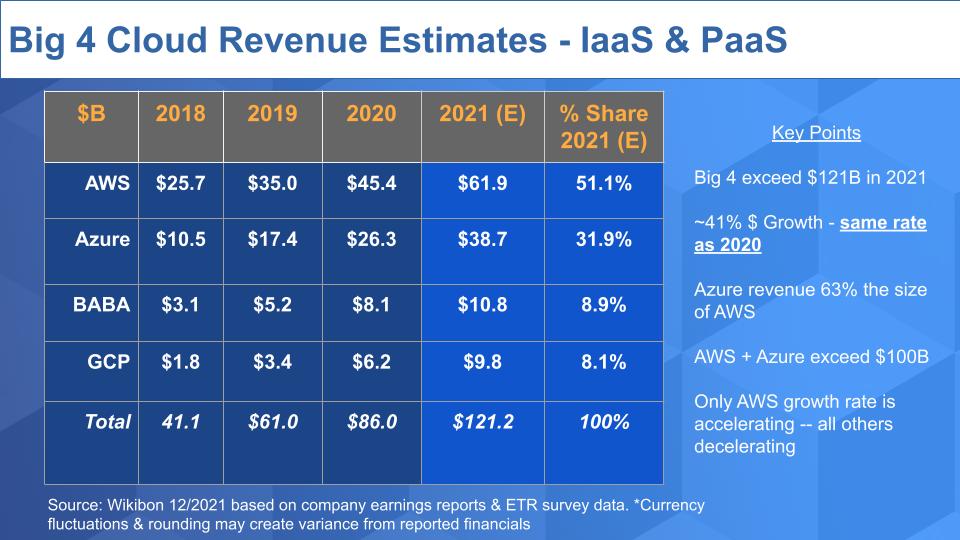
Above is an updated chart from the one we showed last month, which at the time excluded Alibaba’s most recent quarter. The change was not material, but the four hyperscalers, which invested more than $100 billion in CapEx last year, will together generate more than $120 billion in revenue this year. And they’re growing at 41% collectively. That is remarkable for such a large base of revenue. And for AWS, the rate of revenue growth is accelerating.
The point is, if you’re going to build a supercloud, why wouldn’t you start by building on top of these platforms (notwithstanding concerns about China with respect to Alibaba)?

Supercloud is not a category within the ETR taxonomy. But we can evaluate some of the companies we’ve been following that we see as building superclouds by looking at ETR survey data. The chart above plots Net Score or spending momentum on the vertical axis and Market Share or presence in the ETR data set on the horizontal axis. Most every name on the chart is building a supercloud of some sort.
Let’s start by calling out AWS and Azure. They stand alone as the cloud leaders. You can debate what’s included in Azure and our previous chart on revenue attempts to strip out the Microsoft SaaS business, but this is a customer view. Customers see Microsoft as a cloud leader – which it is – so that’s why its presence is larger than AWS even though its IaaS revenue is significantly smaller. But they both have strong momentum on the vertical axis as shown by that red horizontal line. Remember, anything above that is considered elevated.
Google cloud, as you see, is well behind those two leaders.
Look at Snowflake. We realize we repeat this often, but Snowflake continues to hold a Net Score in the mid-to-high 70’s and, at 165 mentions – which you can see in the inserted table – continues to expand its market presence.
Of all the technology companies we track, we feel Snowflake’s vision and execution on its data cloud strategy is the most prominent example of a supercloud. Truly, every tech company should be paying attention to Snowflake’s moves and carving out unique value propositions for their customers by standing on the shoulders of cloud giants (as ChaosSearch CEO Ed Walsh likes to say as his company contemplates its supercloud buildout).
In general, the more cloud-native the firm’s offering, the further along they’ll be toward building a supercloud — and the greater the momentum they’ll have. But typically these firms are coming from a smaller installed base and have foreclosed on the on-premises opportunity (for now).
On the left hand side of the chart above, you can see a number of companies we spoke with that are in various stages of building out their superclouds. Databricks, ThoughSpot Inc., DataRobot Inc., Zscaler, HashiCorp, Elastic N.V., Confluent Inc. – all above the 40% line. And somewhat below that line but still respectable, are those with a significant on-prem presence – VMware Inc. with Tanzu, Cohesity Inc., Rubrik Inc. and Veeam Software Inc. And there are many others that we didn’t necessarily talk to at re:Invent or they don’t show up in the ETR data set.
We’ve called out Cisco Systems Inc., Dell Technologies Inc., Hewlett Packard Enterprise Co. and IBM on the chart because they all have large on-premises installed bases and different points of view. To varying degrees they are each building superclouds.
But to be frank, these large companies are first protecting their respective on-prem turf. You can’t blame them. They are all adding as-a-service offerings, which is cloudlike. They will rightly fight hard and compete on their respective portfolios, channels and vastly improved simplicity.
But when speaking to customers at re:Invent – and these are not just startups we talk to, since we’re talking about customers of enterprise tech companies like these – the customers want to build on AWS. They will fully admit they can’t or won’t move everything out of their data centers, but the vast majority of customers we spoke with have much more momentum around moving toward AWS.
Yes, of course there’s some recency bias because we just got back from re:Invent and it’s a conference full of Amazon customers, but the pace of play, the business savvy and the transformative mindset of these customers is obvious. And the numbers we shared earlier simply don’t lie. These customers are among the firms consuming technology and transforming their business at the most rapid pace.
Regarding these four players, they are starting to move in the supercloud direction — but they are late to the party. Nonetheless, a big strategic advantage is they have more credibility around multicloud than the hyperscalers. But on balance, AWS’ overall lead is accelerating in our opinion, the gap in my opinion is not closing.
In and around 2010 and 2011 we collaborated with two individuals who shaped our thinking about the big-data market. Peter Goldmacher at the time was a sell-side analyst at Cowen & Co. and Abhi Mehta was with Bank of America, transforming the bank’s data operations. Goldmacher said at the time that it was the buyers of big-data technologies – and those that applied it to their operations — that would create the most value. He posited that they would create far more value than Cloudera Inc. or Hortonworks Inc., for example, and a collection of other big data players. Clearly he was right.
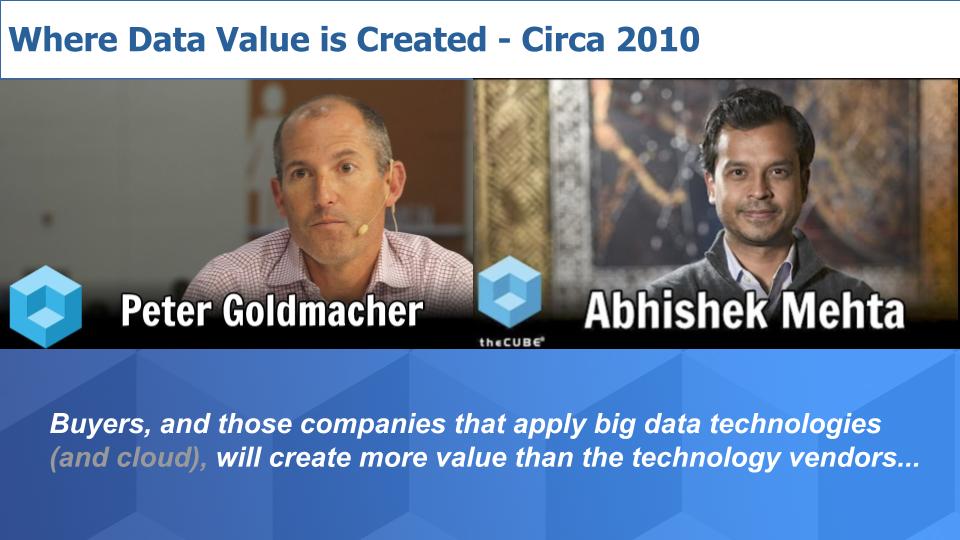
Mehta was a shining example of that premise and he posited on theCUBE that ecosystems would evolve within vertical industries around data — and the confluence of data and technology and machine intelligence would power the next generation of value creation.
Fast forward and apply this thinking to 2021….

Just after the first re:Invent, we published a post on Wikibon about the making of a new gorilla – AWS. And we said the way to compete would be to take an industry focus and become best-of-breed within your industry. We aligned with Mehta’s view that industry ecosystems would evolve around data and offer opportunities for nonhyperscalers to add value. What we didn’t predict at the time – but are seeing clearly emerge – is that these superclouds will be built on top of AWS and other clouds.
Goldman’s Financial Cloud for data is taking a page out of Amazon’s retail business: pointing its proprietary data, algorithms, tools and processes at its clients and making these assets available as a service on top of the AWS cloud. It’s a supercloud for financial services. It is relying on AWS for infrastructure, compute, storage, networking, security and services around machine learning to power its supercloud.
Nasdaq and Dish are similarly bringing forth their unique value. As we said earlier, United Airlines will in our view eventually evolve from migrating its apps to the cloud to building out a supercloud for travel.
This trend is taking shape in virtually every industry and geography and will establish a new breed of disruptive winners. Incumbents that move fast and capitalize on this trend will thrive in our view.
What about your logo? What is your supercloud strategy? We’re sure you’ve been thinking about it. Or perhaps you’re already well down the road. We’d love to hear how you’re doing it and whether you see the trends the same or differently.
Remember we publish each week on Wikibon and SiliconANGLE. These episodes are all available as podcasts wherever you listen.
Email david.vellante@siliconangle.com, DM @dvellante on Twitter and comment on our LinkedIn posts.
Also, check out this ETR Tutorial we created, which explains the spending methodology in more detail. Note: ETR is a separate company from Wikibon and SiliconANGLE. If you would like to cite or republish any of the company’s data, or inquire about its services, please contact ETR at legal@etr.ai.
Here’s the full video analysis:
All statements made regarding companies or securities are strictly beliefs, points of view and opinions held by SiliconANGLE media, Enterprise Technology Research, other guests on theCUBE and guest writers. Such statements are not recommendations by these individuals to buy, sell or hold any security. The content presented does not constitute investment advice and should not be used as the basis for any investment decision. You and only you are responsible for your investment decisions.
THANK YOU